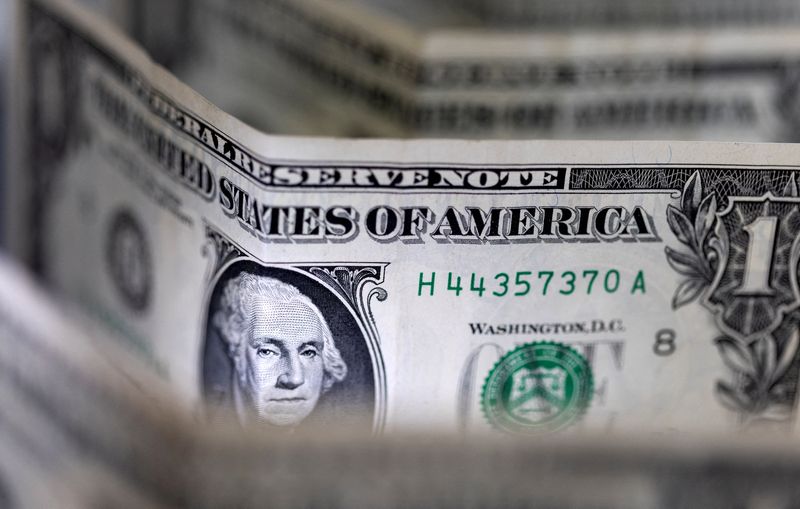Street Calls of the Week
Investing.com - The U.S. dollar slipped slightly lower Thursday as expectations of Federal Reserve rate cuts grew while trade uncertainties remained..
At 04:10 ET (08:10 GMT), the Dollar Index, which tracks the greenback against a basket of six other currencies, traded 0.1% lower to 97.877, after a 0.6% slide in the previous session.
Initial jobless claims due
The greenback has been on the slide after last week’s disappointing jobs report, with weak U.S. services sector activity earlier in the week adding to the notion that the Trump administration’s tariffs are impacting the U.S. economy negatively.
Weekly initial jobless claims are due later in the session, and are expected to show that initial claims for unemployment benefits rose by 3,000 to 221,000 for the week ended August 2.
Traders are pricing in around a 94% chance of a Fed cut in September, up from 48% a week ago, according to the CME Group’s FedWatch Tool. In total, traders see 60.5 basis points in cuts this year.
Investors will also be keeping an eye on the global tariffs landscape, with U.S. President Donald Trump stating late Wednesday evening, via social media, that his trade tariffs on major economies will take effect from midnight.
Also weighing on the U.S. currency are worries over the independence of key U.S. institutions, in the wake of Trump firing the official responsible for collating labor data last week.
Trump shortly has to fill a vacancy on the Fed’s Board of Governors, and is also discussing candidates for the next chair of the central bank.
“We think the nomination of Kevin Hassett, who is considered the frontrunner, is a negative event for the dollar due to his dovish views and greater perceived exposure to Trump’s influence compared to the other main candidate, Kevin Warsh,” said ING, in a note.
Euro helped by Ukraine peace talk
In Europe, EUR/USD rose 0.2% to 1.1689, with the single currency helped by reports that Trump could meet Russian leader Vladimir Putin as soon as next week, as the U.S. kept up pressure on Moscow to end the war in Ukraine.
“Trump’s optimism on a Ukraine-Russia truce is likely feeding into euro strength, which stands in complete opposition to the dollar on the matter,” said ING. “Should a truce become a more tangible prospect, EUR/USD and EUR/CHF are expected to serve as the primary channels for euro appreciation.”
Data released earlier Thursday showed that Germany’s industrial output fell more than expected in June, dropping 1.9% compared with the previous month, as the positive impact from companies rushing to beat U.S. tariffs waned.
GBP/USD rose 0.2% to 1.3378, gaining ahead of a policy-setting meeting of the Bank of England later in the session.
The U.K.’s central bank is widely expected to cut its key interest rate to 4% from 4.25% on Thursday, making it five cuts in the past year.
Investors will be looking for its future guidance given the difficult balance the members have to negotiate between a slowing jobs market and nagging inflation worries.
“The reaction in sterling will be primarily driven by the vote split; expect dissenters on both sides,” said ING. “At least one member (Catherine Mann) should vote for a hold, and might be joined by two more (Huw Pill and Megan Greene), although this is not our base case. Arch-dove Swati Dhingra should vote for 50bp, with some risks of fellow dove Alan Taylor joining her.”
Yuan helped by trade data
Elsewhere, USD/JPY traded 0.3% lower to 146.94, even after confusing reports suggesting Washington intended to add its 15% levy on to already existing tariffs on Japanese goods.
AUD/USD rose 0.4% to 0.6526, benefiting from a stronger-than-expected trade balance for June. The figure was driven by a 6% jump in exports, which rebounded sharply from a deep contraction in the prior month.
USD/CNY slipped 0.1% to 7.1788, after data showed the country’s trade balance shrank more than expected in July.
But China’s exports surged 7.2%, blowing past expectations as local exporters took advantage of a trade truce with Washington. The softer trade balance was in part driven by an unexpected, 4.1% rise in imports, although the figure also showed some resilience in Chinese demand.
